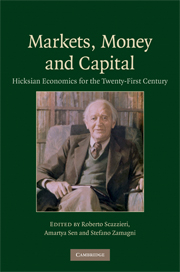Book contents
- Frontmatter
- Contents
- List of figures
- List of tables
- List of contributors
- Preface and acknowledgments
- Between theory and history: on the identity of Hicks's economics
- Part I The Intellectual Heritage of John Hicks
- 1 Hicks on liberty
- 2 An economist even greater than his high reputation
- 3 Hicks's ‘conversion’ – from J. R. to John
- 4 Dear John, Dear Ursula (Cambridge and LSE, 1935): eighty-eight letters unearthed
- 5 Hicks and his publishers
- 6 Hicks in reviews, 1932–89: from The Theory of Wages to A Market Theory of Money
- Part II Markets
- Part III Money
- Part IV Capital and Dynamics
- References
- Name index
- Subject index
3 - Hicks's ‘conversion’ – from J. R. to John
Published online by Cambridge University Press: 29 June 2009
- Frontmatter
- Contents
- List of figures
- List of tables
- List of contributors
- Preface and acknowledgments
- Between theory and history: on the identity of Hicks's economics
- Part I The Intellectual Heritage of John Hicks
- 1 Hicks on liberty
- 2 An economist even greater than his high reputation
- 3 Hicks's ‘conversion’ – from J. R. to John
- 4 Dear John, Dear Ursula (Cambridge and LSE, 1935): eighty-eight letters unearthed
- 5 Hicks and his publishers
- 6 Hicks in reviews, 1932–89: from The Theory of Wages to A Market Theory of Money
- Part II Markets
- Part III Money
- Part IV Capital and Dynamics
- References
- Name index
- Subject index
Summary
Introduction
How many Hickses do we know? Looking at the signatures of his papers, and hence at his bibliography, one suspects that there have been at least two: J. R. Hicks, from the beginning of his career in the 1930s to the end of the 1960s, and John Hicks, from the 1970s onwards. Was this change of name a whimsical caprice of a successful economist, or was it a meditated choice? An answer comes from Hicks himself. In 1975 (Hicks, 1975b: 365) he emphatically writes: ‘J. R. Hicks…[is] a “neoclassical” economist now deceased … John Hicks [is] a non-neo-classic who is quite disrespectful towards his “uncle.”’
Hence, Hicks changed his name because he changed his mind. John, the ‘nephew,’ came to develop different ideas about economic theory from J. R., the ‘uncle.’ This is a startling and intriguing occurrence; to be fair, though quite unique in the form, it is not entirely in the substance.
In the natural sciences in particular, where eager attention to new evidence is most keenly paid, changes of mind are not exceptionally rare events. Even in economics, one can cite several cases of a sharp change of mind.
- Type
- Chapter
- Information
- Markets, Money and CapitalHicksian Economics for the Twenty First Century, pp. 52 - 71Publisher: Cambridge University PressPrint publication year: 2009
- 3
- Cited by



